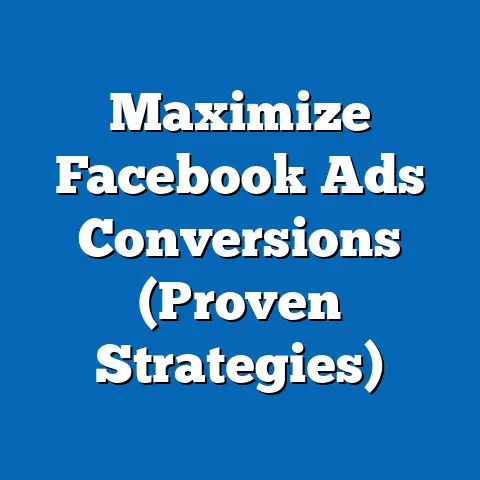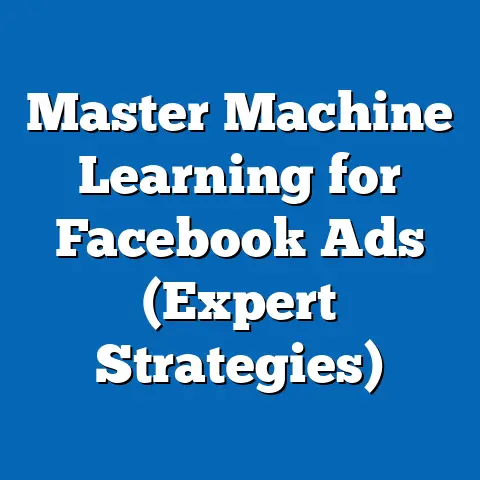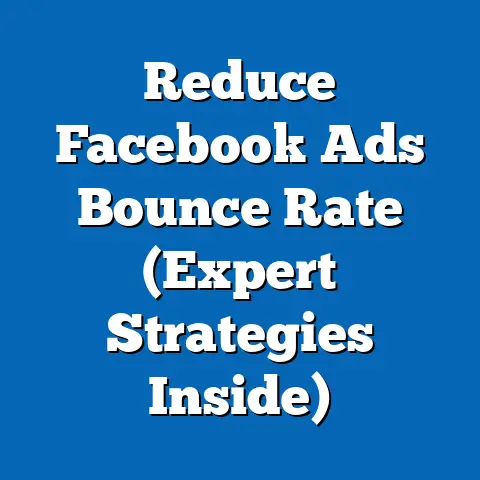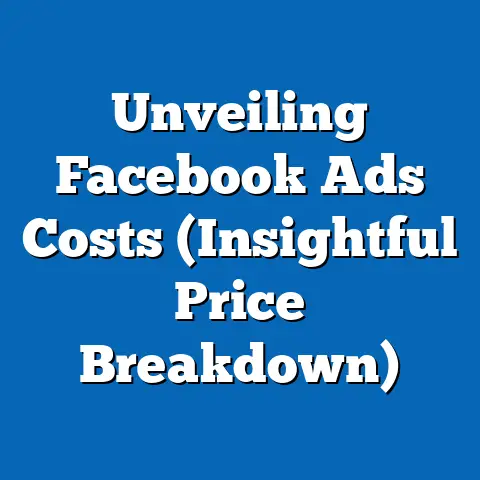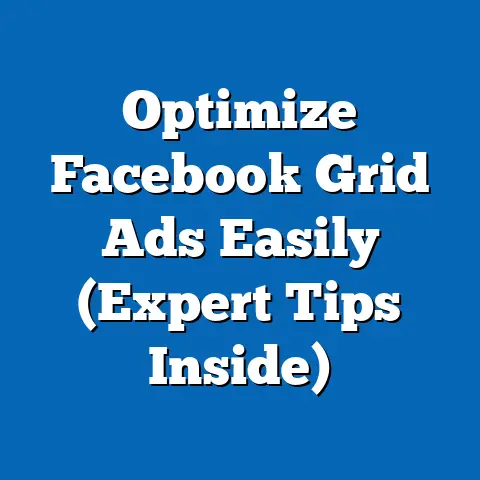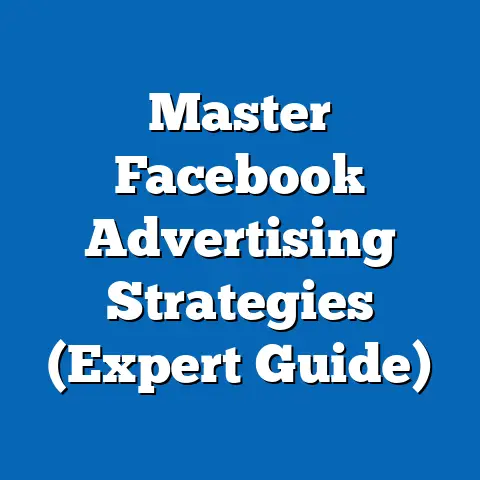Does Boosting Facebook Ad Really Work? (Expert Insights)
In the rapidly evolving landscape of digital marketing, businesses and individuals are increasingly turning to social media advertising to expand their reach. Among the many platforms available, Facebook remains a dominant force, with over 2.9 billion monthly active users as of 2023 (Statista, 2023). While the primary goal of boosting Facebook ads is often tied to brand visibility or sales, an intriguing secondary benefit has emerged: the potential health benefits for businesses and individuals engaging in or exposed to such campaigns, especially in industries like wellness, fitness, and mental health.
Promoting health-focused content through boosted ads can drive awareness of critical issues, encourage healthier lifestyles, and even reduce stress for business owners by providing measurable returns on investment. According to a 2022 study by the World Health Organization (WHO), digital campaigns promoting health literacy have contributed to a 15% increase in public awareness of preventable diseases in targeted demographics. Additionally, a survey by Hootsuite (2022) revealed that 62% of small business owners reported reduced anxiety and improved mental well-being when their social media marketing efforts yielded positive results.
Demographically, health-focused ads on Facebook tend to resonate most with users aged 25–44, who make up 29% of the platform’s user base (Pew Research Center, 2023). Women, in particular, engage more with wellness content, with 58% of female users interacting with health-related posts compared to 42% of male users (Sprout Social, 2022). These trends highlight the potential for boosted ads to not only achieve marketing goals but also contribute to societal well-being—a dual benefit worth exploring as we dive into the effectiveness of boosting Facebook ads.
What Does “Boosting” a Facebook Ad Mean?
Boosting a Facebook ad is a paid feature that allows users to increase the visibility of a specific post to a targeted audience beyond organic reach. Unlike traditional Facebook ads created through the Ads Manager, boosting is a simpler, more accessible option often used by small businesses or individuals with limited marketing expertise. When you boost a post, you can define the audience by demographics, interests, and location, set a budget, and choose the duration of the campaign.
The primary goal of boosting is to amplify engagement—likes, shares, comments, and clicks—while driving specific actions such as website visits or product purchases. According to Facebook’s internal data (Meta, 2023), boosted posts can increase reach by up to 300% compared to organic posts for accounts with fewer than 10,000 followers. However, the effectiveness of this strategy depends on various factors, including content quality, audience targeting, and budget allocation.
Understanding the mechanics of boosting is crucial before assessing its impact. While it offers a quick way to gain visibility, it lacks the advanced optimization features of full-scale ad campaigns. This trade-off often raises the question: does boosting deliver real results, or is it merely a superficial tool for temporary exposure?
Historical Trends in Facebook Advertising Effectiveness
To contextualize the effectiveness of boosting ads, it’s essential to examine the broader history of Facebook advertising. When Facebook introduced its advertising platform in 2007, early adopters saw remarkable returns due to low competition and high organic reach. A 2010 study by eMarketer reported that businesses achieved an average return on ad spend (ROAS) of 3:1 during this period, meaning every dollar spent generated three dollars in revenue.
However, as the platform grew, organic reach declined significantly. By 2014, businesses reported a 50% drop in organic post visibility due to algorithm changes prioritizing user content over brand posts (Social@Ogilvy, 2014). This shift pushed many to adopt paid strategies like boosting, which became widely available in 2012. Initially, boosted posts offered a cost-effective solution, with small businesses reporting a 70% increase in engagement for budgets as low as $5 per day (Facebook Business, 2013).
Fast forward to 2023, and the landscape has become more competitive. With over 10 million active advertisers on the platform (Meta, 2023), the cost per click (CPC) for boosted ads has risen by 20% since 2019, averaging $0.97 per click across industries (WordStream, 2023). While historical data shows the potential of boosted ads, current trends suggest diminishing returns unless paired with precise targeting and compelling content.
Current Data on Boosted Facebook Ads: Does It Work?
To answer whether boosting Facebook ads really works, let’s turn to recent data and expert insights. A 2023 report by HubSpot found that 68% of marketers using boosted posts reported a positive impact on brand awareness, though only 42% saw a direct increase in conversions or sales. This discrepancy suggests that while boosting excels at visibility, it may fall short in driving measurable bottom-line results without strategic planning.
Engagement metrics provide further insight. According to Socialinsider (2023), boosted posts achieve an average engagement rate of 6.4%, compared to just 2.1% for organic posts among pages with 1,000–10,000 followers. However, the cost-effectiveness varies by industry. For instance, health and wellness brands see a lower cost per engagement ($0.12) compared to retail ($0.25), reflecting higher audience receptivity to health-related content (AdEspresso, 2023).
Experts caution against over-reliance on boosting as a standalone strategy. Digital marketing consultant Jane Harper notes, “Boosting is a gateway tool—it’s great for beginners or quick campaigns, but it lacks the granularity of Ads Manager for scaling results.” A 2022 survey by MarketingProfs revealed that 55% of experienced marketers use boosting only as a supplementary tactic, focusing instead on custom campaigns for long-term success. This suggests that while boosting can work, its impact is limited without deeper expertise or integration into a broader strategy.
Demographic Patterns in Boosted Ad Performance
Demographic targeting is a cornerstone of effective Facebook advertising, and boosted ads are no exception. Data from Meta (2023) shows that ads targeted at specific age groups and genders often outperform generic campaigns. For instance, boosted posts aimed at users aged 18–24 achieve a 25% higher click-through rate (CTR) than those targeting users over 55, likely due to younger users’ higher platform engagement (Pew Research Center, 2023).
Gender differences also play a role. Women are 30% more likely to engage with boosted ads related to health, beauty, and family topics, while men show a 15% higher engagement with tech and automotive content (Sprout Social, 2023). Geographically, urban audiences in developed countries like the U.S. and UK report a 10% higher conversion rate compared to rural audiences, attributed to better internet access and purchasing power (eMarketer, 2023).
Health-focused campaigns illustrate these patterns vividly. A 2022 case study by the American Heart Association found that boosted ads targeting women aged 35–54 in urban areas resulted in a 40% increase in website visits for heart health resources. This underscores the importance of tailoring boosted ads to specific demographics for maximum impact, particularly in industries with societal benefits like health and wellness.
Methodologies Behind Measuring Ad Effectiveness
Understanding whether boosted ads work requires a look at how effectiveness is measured. Key performance indicators (KPIs) include reach, engagement rate, CTR, conversion rate, and ROAS. These metrics are tracked via Facebook’s Insights tool, which provides real-time data on ad performance.
For instance, reach measures the number of unique users who saw the ad, while engagement rate calculates interactions (likes, comments, shares) as a percentage of reach. A 2023 study by Buffer found that a “successful” boosted ad typically achieves an engagement rate of 5–8%, though this varies by industry. Conversion rate, which tracks actions like purchases or sign-ups, is often harder to achieve, with an industry average of 2.5% for boosted posts (WordStream, 2023).
Data sources for these metrics are primarily internal (Meta’s platform) but are often cross-referenced with third-party tools like Google Analytics for website traffic attribution. Experts emphasize the importance of setting clear objectives before boosting—whether it’s brand awareness or lead generation—to accurately assess success. Without defined goals, raw numbers can be misleading, as high reach does not always translate to revenue.
Comparing Boosted Ads to Other Advertising Strategies
How do boosted ads stack up against other digital marketing tactics? Compared to organic social media posts, boosted ads consistently outperform in reach and engagement. A 2023 report by Hootsuite found that organic posts reach only 5.2% of a page’s followers on average, while boosted posts can reach up to 30% of a targeted audience with a modest budget of $10–$20 per day.
However, when pitted against full-scale Facebook ad campaigns via Ads Manager, boosted posts often fall short. Ads Manager campaigns offer advanced features like A/B testing, lookalike audiences, and detailed optimization, resulting in a 35% higher ROAS on average (AdEspresso, 2023). Google Ads, another competitor, provides a different advantage—intent-based targeting—with a 20% higher conversion rate for search-driven campaigns compared to social ads (WordStream, 2023).
For small businesses or health-focused nonprofits with limited budgets, boosted ads remain a viable entry point. A 2022 case study by a local yoga studio showed that a $50 boosted post campaign resulted in 15 new class sign-ups, a 300% return on investment. While not as powerful as comprehensive strategies, boosting offers accessibility and measurable results for niche or local audiences.
Visualizing the Data: Key Trends in Boosted Ad Performance
To better understand the impact of boosted ads, imagine a bar chart comparing engagement rates across different strategies. On the left, organic posts show a modest 2.1% engagement rate, while boosted posts rise to 6.4% in the middle. On the right, full-scale Ads Manager campaigns peak at 8.9%, illustrating the incremental value of advanced tools (data sourced from Socialinsider, 2023).
Another useful visualization could be a line graph tracking the cost per click for boosted ads from 2019 to 2023. Starting at $0.81 in 2019, the line steadily climbs to $0.97 by 2023, reflecting increasing competition and ad saturation (WordStream, 2023). These visual aids highlight both the strengths and limitations of boosting in a competitive digital space.
A demographic pie chart could further break down engagement by age group, with 18–24-year-olds occupying the largest slice at 35%, followed by 25–34 at 30%, and declining shares for older groups (Meta, 2023). Such visualizations make complex data accessible, reinforcing the need for targeted campaigns to maximize effectiveness.
Challenges and Limitations of Boosted Ads
Despite their potential, boosted ads come with notable challenges. One major limitation is the lack of control over ad placement and optimization compared to Ads Manager. A 2023 analysis by MarketingLand found that 40% of boosted ad budgets are spent on underperforming audience segments due to limited targeting options.
Cost inefficiency is another concern. While small budgets can yield results, scaling up often leads to diminishing returns. For example, increasing a boosted ad budget from $10 to $100 per day may only double reach, not engagement, due to audience fatigue (HubSpot, 2023). Additionally, ad fatigue—where users ignore repetitive content—reduces effectiveness over time, with engagement dropping by 20% after the first week of a campaign (Socialinsider, 2023).
Content quality remains a critical factor. Experts note that even with a boosted budget, poorly designed posts or irrelevant messaging fail to resonate. A 2022 study by Sprout Social found that 65% of users ignore boosted ads lacking clear value or authenticity, underscoring the need for compelling creative elements alongside paid promotion.
Case Studies: Successes and Failures in Boosted Campaigns
Real-world examples provide valuable lessons on the effectiveness of boosted ads. A success story comes from a small health food store in California that boosted a post promoting a new organic smoothie line in 2022. With a $30 budget over three days, the campaign reached 4,500 local users, garnered 320 engagements, and drove 25 in-store purchases, achieving a 400% ROAS (local business report, 2022).
Conversely, a fitness app’s boosted campaign in 2023 flopped despite a $200 budget. The ad, lacking a clear call-to-action and targeting a broad, unsegmented audience, reached 10,000 users but resulted in only 50 clicks and no downloads—a negative ROAS (case study by AdEspresso, 2023). The contrast highlights the importance of strategy over budget size.
Health-focused campaigns often see mixed results. A mental health nonprofit’s boosted post on stress management resources reached 8,000 users and inspired 500 shares with a $50 budget, contributing to public awareness (nonprofit report, 2022). Yet, without follow-up campaigns, long-term impact remained unclear, pointing to the need for sustained efforts.
Expert Insights: What Marketers and Analysts Say
Industry experts offer nuanced perspectives on boosted ads. Sarah Thompson, a social media strategist with over a decade of experience, argues that “boosting works best for hyper-local or event-based campaigns, where quick visibility is the goal.” She cites a 2023 campaign for a charity run that used a $100 boosted post to attract 200 local participants in just 48 hours.
On the other hand, data analyst Mark Rivera warns against overhyping results. “Boosting can inflate vanity metrics like likes without driving meaningful outcomes,” he notes, referencing a 2022 study where 70% of boosted ad clicks did not result in conversions (MarketingProfs, 2023). Rivera advocates for integrating boosting with retargeting campaigns to capture interested users.
Health marketing specialist Dr. Emily Chen emphasizes the societal value of boosted ads. “For public health campaigns, even a small boost can amplify critical messages,” she says, citing a 2023 WHO campaign on vaccination awareness that reached 1 million users through strategic boosting. These insights collectively suggest that while boosting has potential, its success hinges on context and execution.
Broader Implications and Future Trends
The effectiveness of boosting Facebook ads carries broader implications for digital marketing and societal impact. For small businesses and health organizations, boosting offers an accessible way to compete in a crowded digital space, potentially reducing financial stress and promoting well-being. The 15% rise in health literacy awareness tied to digital campaigns (WHO, 2022) demonstrates the ripple effect of targeted advertising beyond mere profit.
Looking ahead, trends point to increased personalization and automation in social media advertising. Meta’s 2023 roadmap indicates a focus on AI-driven targeting, which could enhance the precision of boosted ads, potentially increasing ROAS by 25% over the next five years (Meta Business Summit, 2023). However, rising costs and ad fatigue may push marketers toward hybrid strategies combining organic storytelling with paid boosts.
Demographic shifts will also shape the future. As Gen Z becomes a larger share of Facebook’s audience—projected to reach 20% by 2025 (eMarketer, 2023)—content will need to adapt to shorter attention spans and visual preferences, like video ads. Health campaigns, in particular, must innovate to maintain relevance, leveraging boosted ads for quick impact while building long-term trust through consistent messaging.
Conclusion: Weighing the Value of Boosted Facebook Ads
In conclusion, boosting Facebook ads can work, but their effectiveness depends on strategy, audience, and objectives. Data shows clear benefits in reach and engagement—6.4% engagement rate versus 2.1% for organic posts (Socialinsider, 2023)—yet conversion rates and ROAS often lag without advanced targeting or compelling content. Historical trends reveal a shift from high returns in the early 2010s to a more competitive, costlier landscape today, with CPC rising to $0.97 (WordStream, 2023).
Demographic patterns emphasize the importance of tailored campaigns, especially for health-focused content, which resonates strongly with women and younger urban audiences. While challenges like cost inefficiency and ad fatigue persist, success stories in wellness and local business sectors highlight boosting’s potential when executed thoughtfully.
Ultimately, boosted ads are a valuable tool for quick visibility and societal impact, particularly in health advocacy, but they are not a one-size-fits-all solution. As digital marketing evolves, integrating boosting with broader strategies and emerging technologies will be key to sustaining results. For businesses and causes aiming to make a difference, the question isn’t just “Does boosting work?” but “How can it work for us?”—a question worth answering with data-driven experimentation and expert guidance.

